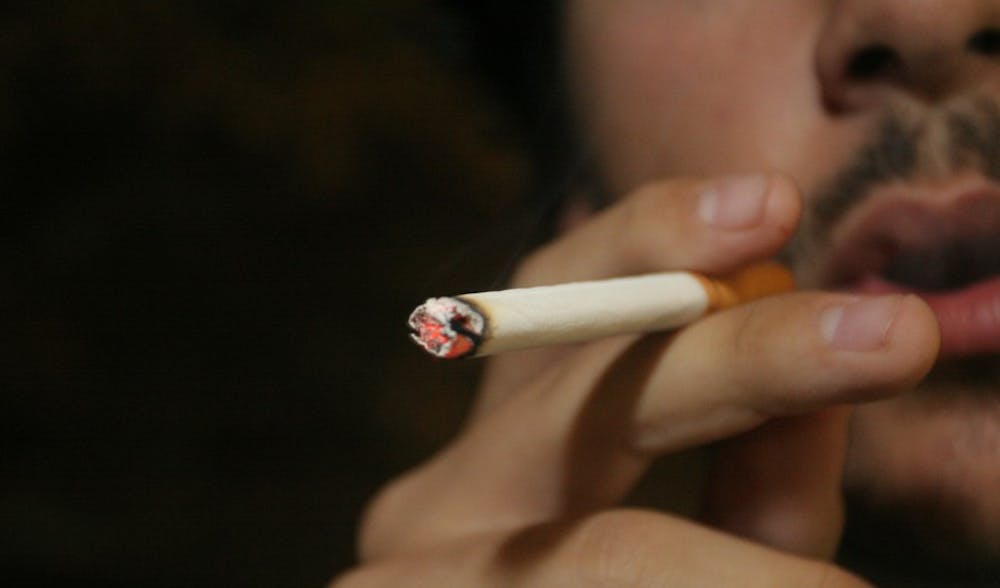
Cutbacks in state funding in 2013 depleted a portion of Penn’s research funds — but while the chunk of lost funding is relatively small, it represents wider struggles in the hunt for research funding.
In 1998, a 46-state lawsuit against the tobacco companies created a pool of funding for health-related research to be distributed by states. Pennsylvania’s allocation of funds was set to drop by $180 million in fall 2013, per an arbitration ruling, because of claims that the state did not adequately tax tobacco companies.
When the research fund consisting of tobacco-company money was frozen in 2013, Penn lost out on one source of its research funding.
From the perspective of overall research funding though, Penn receives 82 percent of its $870 million in funding from the federal government. Of the total funds, only about one or two percent comes from state funding.
The Commonwealth Universal Research Enhancement Program funds grants for research in health fields. Established in 2001 with funds from the Tobacco Settlement Fund, the culmination of the 46-state lawsuit, CURE is run through the Pennsylvania Department of Health.
In response to the arbitration ruling, Pennsylvania froze all CURE funding in the state, a sum of what would have been over $40 million. Consequentially, Penn and the other institutions receiving CURE funding were not allocated funds during the 2013-14 fiscal year.
Assistant professor in the Wistar Institute’s NCI-designated Cancer Center’s Molecular and Cellular Oncogenesis program Jessie Villanueva has utilized CURE funds to further her research in melanoma. Because Villanueva’s CURE funding has already been expended, she has not been affected directly by the depletion of funds, although she said other researchers’ work may be compromised.
“I think overall we are all concerned about the funding climate right now,” Villanueva said. “It’s very difficult to get funding from the federal government in general, so having resources from the state was a big deal for us.”
She noted she and her peers must submit ten grant applications in order to receive a single grant.
In the 2008 to 2009 fiscal year, Penn received $8,975,120 of formula grants through the CURE program. The University received its peak CURE allocation during the 2009 to 2010 fiscal year, when it was allocated $9,897,440 in formula grants, although the quantity was still a mere one percent of its current total research funds.
Yet, although the lost funds quantify a small chunk of Penn’s total funding, the decrease illustrates greater challenges arising from uncertainty in research funding.
Director of Research Initiatives in the Office of the Vice Provost for Research Marc Rigas said that his office often receives calls from faculty members who fear struggles to find funding — both from the CURE program and otherwise — may implicate the future of their research.
“Any time you have funding uncertainty, it’s detrimental to the university,” Rigas said, stressing the fact that individual researchers field the hardest hit. “If you’re the person who’s lab is receiving those funds, it’s a big portion of your budget.”
But, in April, a Court of Common Pleas judge ruled to restore an estimated $120 million of Pennsylvania’s $335 million tobacco settlement funds for 2014.
Penn will receive about $5 million in funding from the CURE program this fiscal year, Rigas said. Most of the funds will go to the Abramson Cancer Center.
The reduction of CURE funding comes amidst a difficult time for researchers seeking funding, with the federal government cutting back on research funding in general.
“Penn’s in a good position because we are a well-respected university with top researchers,” Rigas said. “Compared to other institutions, we’ll be okay, but because the pie is getting smaller, top universities are going to be competing more and more for these funds.”
In 2004, the National Institutes of Health, one of the largest funders of science research, received 40,861 grant applications with an overall success rate of 24.6 percent.
Nine years later, in 2013, the NIH received 49,581 grant applications, and the funding rate dropped to 16.8 percent — meaning researchers are roughly 32 percent less likely to obtain funding.
“Faculty members are spending more time writing applications for grants than doing actual research,” Rigas said.
The Wistar Institute, Penn’s cancer-focused research neighbor, has also received less funding than expected due to CURE program cuts.
According to Wistar’s website, the institute expected to receive approximately $1,403,000 in CURE funding in 2014. Wistar will now take on a “substantial deficit” this fiscal year in order to continue funded research projects.
The Daily Pennsylvanian is an independent, student-run newspaper. Please consider making a donation to support the coverage that shapes the University. Your generosity ensures a future of strong journalism at Penn.
DonatePlease note All comments are eligible for publication in The Daily Pennsylvanian.





